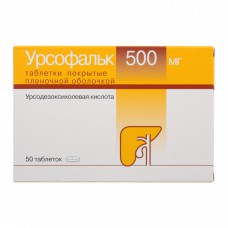Expiration date: 10/2026
Pharmacodynamics
Ursodeoxycholic acid is found in small amounts in human bile. When taken orally, it reduces the saturation of bile with CS by inhibiting its absorption in the intestine and reducing its secretion into the bile, contributing to the dissolution of CS concretions. The effect of ursodeoxycholic acid in liver diseases and cholestatic diseases is due to the relative replacement of lipophilic, detergent-like, toxic bile acids with hydrophilic, cytoprotective, non-toxic ursodeoxycholic acid, as well as the improvement of the secretory ability of hepatocytes and immunoregulatory processes.
Pharmacokinetics
When taken orally, ursodeoxycholic acid is rapidly absorbed in the jejunum and in the upper ileum due to passive, and in the terminal ileum — active transport. The degree of absorption is 60-80%. After resorption in the intestine, it is almost completely conjugated in the liver with the amino acids glycine and taurine, and after that it is again excreted with bile. The effect of the primary passage through the liver is 60%. In the intestine, bacterial decomposition into 7-keto-litocholic acid partially occurs. Litocholic acid is hepatotoxic and in the experiment can cause damage to the liver parenchyma. In humans, only a small part of it is resorbed, this part is sulfated and, thus, detoxified in the liver, then again excreted with bile and finally-with feces. T? ursodeoxycholic acid is 3.5–5.8 days.
INDICATIONS:
for the lysis of CS-concretions in the gallbladder (no more than 15 mm in diameter, X-ray negative, provided that the gallbladder is functioning), gastritis caused by bile reflux, symptomatic treatment of primary biliary cirrhosis in the compensation phase.


